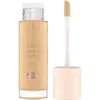What's inside
What's inside
 Key Ingredients
Key Ingredients

 Benefits
Benefits

 Concerns
Concerns

No concerns
 Ingredients Side-by-side
Ingredients Side-by-side

Water
Skin ConditioningHydrogenated Polyisobutene
EmollientIsononyl Isononanoate
EmollientPropanediol
SolventGlycerin
HumectantPolyglyceryl-3 Polyricinoleate
EmulsifyingPolyglyceryl-3 Diisostearate
EmulsifyingDisteardimonium Hectorite
StabilisingSorbitan Isostearate
EmulsifyingMagnesium Sulfate
Sodium Dehydroacetate
PreservativeCaprylyl Glycol
Emollient1,2-Hexanediol
Skin ConditioningMagnesium Stearate
Cosmetic ColorantTocopheryl Acetate
AntioxidantSodium Lauroyl Glutamate
Lysine
Skin ConditioningMagnesium Chloride
Sodium Hyaluronate
HumectantCassia Angustifolia Seed Polysaccharide
Skin ConditioningCentella Asiatica Extract
CleansingLactobacillus Ferment Lysate
Skin ConditioningCamellia Sinensis Leaf Extract
AntimicrobialPunica Granatum Bark/Fruit Extract
AntimicrobialLactobacillus Ferment
Skin ConditioningCaffeine
Skin ConditioningCI 77002
Cosmetic ColorantCI 77891
Cosmetic ColorantIron Oxides
Water, Hydrogenated Polyisobutene, Isononyl Isononanoate, Propanediol, Glycerin, Polyglyceryl-3 Polyricinoleate, Polyglyceryl-3 Diisostearate, Disteardimonium Hectorite, Sorbitan Isostearate, Magnesium Sulfate, Sodium Dehydroacetate, Caprylyl Glycol, 1,2-Hexanediol, Magnesium Stearate, Tocopheryl Acetate, Sodium Lauroyl Glutamate, Lysine, Magnesium Chloride, Sodium Hyaluronate, Cassia Angustifolia Seed Polysaccharide, Centella Asiatica Extract, Lactobacillus Ferment Lysate, Camellia Sinensis Leaf Extract, Punica Granatum Bark/Fruit Extract, Lactobacillus Ferment, Caffeine, CI 77002, CI 77891, Iron Oxides
Water
Skin ConditioningHydrogenated Didecene
Skin ConditioningIsododecane
EmollientGlycerin
HumectantPropanediol
SolventSqualane
EmollientPolyglyceryl-4 Oleate
EmulsifyingHydrogenated Styrene/Isoprene Copolymer
Polyglyceryl-3 Polyricinoleate
EmulsifyingMagnesium Sulfate
Tocopherol
AntioxidantSynthetic Fluorphlogopite
Triethoxycaprylylsilane
Pentaerythrityl Tetra-Di-T-Butyl Hydroxyhydrocinnamate
AntioxidantPhenoxyethanol
PreservativeCI 77163
Cosmetic ColorantCI 77491
Cosmetic ColorantCI 77492
Cosmetic ColorantCI 77891
Cosmetic ColorantWater, Hydrogenated Didecene, Isododecane, Glycerin, Propanediol, Squalane, Polyglyceryl-4 Oleate, Hydrogenated Styrene/Isoprene Copolymer, Polyglyceryl-3 Polyricinoleate, Magnesium Sulfate, Tocopherol, Synthetic Fluorphlogopite, Triethoxycaprylylsilane, Pentaerythrityl Tetra-Di-T-Butyl Hydroxyhydrocinnamate, Phenoxyethanol, CI 77163, CI 77491, CI 77492, CI 77891
 Reviews
Reviews

Ingredients Explained
These ingredients are found in both products.
Ingredients higher up in an ingredient list are typically present in a larger amount.
Ci 77891 is a white pigment from Titanium dioxide. It is naturally found in minerals such as rutile and ilmenite.
It's main function is to add a white color to cosmetics. It can also be mixed with other colors to create different shades.
Ci 77891 is commonly found in sunscreens due to its ability to block UV rays.
Learn more about CI 77891Glycerin is already naturally found in your skin. It helps moisturize and protect your skin.
A study from 2016 found glycerin to be more effective as a humectant than AHAs and hyaluronic acid.
As a humectant, it helps the skin stay hydrated by pulling moisture to your skin. The low molecular weight of glycerin allows it to pull moisture into the deeper layers of your skin.
Hydrated skin improves your skin barrier; Your skin barrier helps protect against irritants and bacteria.
Glycerin has also been found to have antimicrobial and antiviral properties. Due to these properties, glycerin is often used in wound and burn treatments.
In cosmetics, glycerin is usually derived from plants such as soybean or palm. However, it can also be sourced from animals, such as tallow or animal fat.
This ingredient is organic, colorless, odorless, and non-toxic.
Glycerin is the name for this ingredient in American English. British English uses Glycerol/Glycerine.
Learn more about GlycerinMagnesium Sulfate is a salt. More specifically, it is an epsom salt, or the bath salt used to help relieve muscle aches.
Despite having ‘sulfate’ in the name, it isn’t a surfactant or cleansing agent like sodium lauryl sulfate. Unlike those sulfates, magnesium sulfate doesn’t have the same cleansing or foaming properties (it's simply a type of salt).
In cosmetics, Magnesium Sulfate is used to thicken a product or help dilute other solids. It is a non-reactive and non-irritating ingredient.
One study shows magnesium deficiency may lead to inflammation of the skin. Applying magnesium topically may help reduce inflammation.
You can find this ingredient in sea water or mineral deposits.
Learn more about Magnesium SulfateThis ingredient is an emulsifier. It is created from Polyglycerin-3 and Ricinoleic Acid.
As an emulsifier, it prevents waters and oils from separating. According to a manufacturer this ingredient is fully biodegradable.
This ingredient may not be safe for Malassezia folliculitis due to its Ricinoleic Acid base. Ricinoleic Acid is a fatty acid derived from castor oil.
Learn more about Polyglyceryl-3 PolyricinoleatePropanediol is an all-star ingredient. It softens, hydrates, and smooths the skin.
It’s often used to:
Propanediol is not likely to cause sensitivity and considered safe to use. It is derived from corn or petroleum with a clear color and no scent.
Learn more about PropanediolWater. It's the most common cosmetic ingredient of all. You'll usually see it at the top of ingredient lists, meaning that it makes up the largest part of the product.
So why is it so popular? Water most often acts as a solvent - this means that it helps dissolve other ingredients into the formulation.
You'll also recognize water as that liquid we all need to stay alive. If you see this, drink a glass of water. Stay hydrated!
Learn more about Water